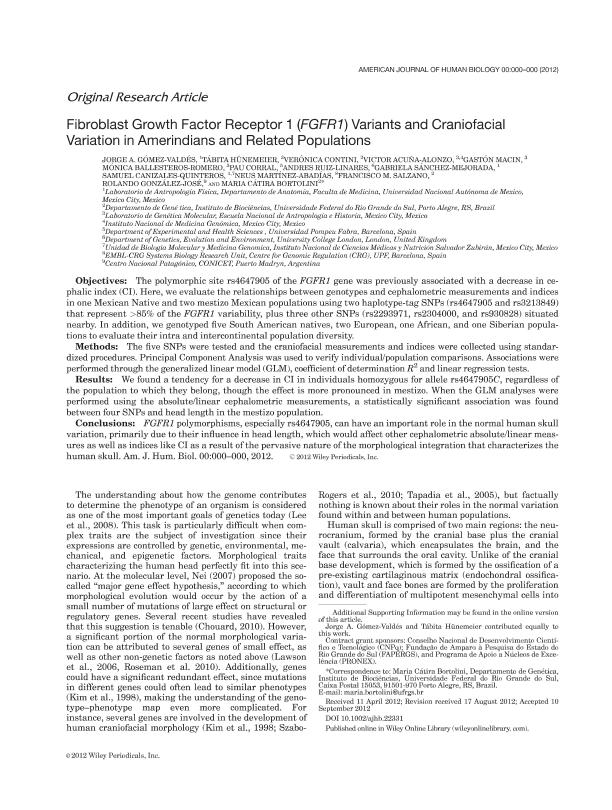Mostrar el registro sencillo del ítem
dc.contributor.author
Gomez Valdes, Jorge
dc.contributor.author
Hünemeier, Tábita
dc.contributor.author
Contini, Verónica
dc.contributor.author
Acuña Alonzo, Victor
dc.contributor.author
Macin, Gastón
dc.contributor.author
Ballesteros Romero, Mónica
dc.contributor.author
Corral, Pau
dc.contributor.author
Ruiz Linares, Andres
dc.contributor.author
Sanchez Mejorada, Gabriela
dc.contributor.author
Canizales Quinteros, Samuel
dc.contributor.author
Martínez Abadías, Neus
dc.contributor.author
Salzano, Francisco M.
dc.contributor.author
Gonzalez Jose, Rolando

dc.contributor.author
Bortolini, Maria Catira
dc.date.available
2016-05-10T20:33:51Z
dc.date.issued
2013-01
dc.identifier.citation
Gomez Valdes, Jorge; Hünemeier, Tábita; Contini, Verónica; Acuña Alonzo, Victor; Macin, Gastón; et al.; Fibroblast Growth Factor Receptor 1 Variants and Craniofacial Variation in Amerindians and Related Populations; Wiley; American Journal of Human Biology; 25; 1; 1-2013; 12-19
dc.identifier.issn
1042-0533
dc.identifier.uri
http://hdl.handle.net/11336/5606
dc.description.abstract
Objectives:
The polymorphic site rs4647905 of the FGFR1 gene was previously associated with a decrease in cephalic index (CI). Here, we evaluate the relationships between genotypes and cephalometric measurements and indices in one Mexican Native and two mestizo Mexican populations using two haplotype-tag SNPs (rs4647905 and rs3213849) that represent >85% of the FGFR1 variability, plus three other SNPs (rs2293971, rs2304000, and rs930828) situated nearby. In addition, we genotyped five South American natives, two European, one African, and one Siberian populations to evaluate their intra and intercontinental population diversity.
Methods:
The five SNPs were tested and the craniofacial measurements and indices were collected using standardized procedures. Principal Component Analysis was used to verify individual/population comparisons. Associations were performed through the generalized linear model (GLM), coefficient of determination R2 and linear regression tests.
Results:
We found a tendency for a decrease in CI in individuals homozygous for allele rs4647905C, regardless of the population to which they belong, though the effect is more pronounced in mestizo. When the GLM analyses were performed using the absolute/linear cephalometric measurements, a statistically significant association was found between four SNPs and head length in the mestizo population.
Conclusions:
FGFR1 polymorphisms, especially rs4647905, can have an important role in the normal human skull variation, primarily due to their influence in head length, which would affect other cephalometric absolute/linear measures as well as indices like CI as a result of the pervasive nature of the morphological integration that characterizes the human skull.
dc.format
application/pdf
dc.language.iso
eng
dc.publisher
Wiley

dc.rights
info:eu-repo/semantics/openAccess
dc.rights.uri
https://creativecommons.org/licenses/by-nc-sa/2.5/ar/
dc.subject
Fibroblast Growth Factor Receptor Gene
dc.subject
Raniofacial Development
dc.subject
Native Americans
dc.subject
Mexican Populations
dc.subject
Cephalic Index
dc.subject.classification
Genética y Herencia

dc.subject.classification
Ciencias Biológicas

dc.subject.classification
CIENCIAS NATURALES Y EXACTAS

dc.title
Fibroblast Growth Factor Receptor 1 Variants and Craniofacial Variation in Amerindians and Related Populations
dc.type
info:eu-repo/semantics/article
dc.type
info:ar-repo/semantics/artículo
dc.type
info:eu-repo/semantics/publishedVersion
dc.date.updated
2016-04-28T14:52:21Z
dc.journal.volume
25
dc.journal.number
1
dc.journal.pagination
12-19
dc.journal.pais
Estados Unidos

dc.journal.ciudad
Hoboken
dc.description.fil
Fil: Gomez Valdes, Jorge. Universidad Nacional Autónoma de México. Facultad de Medicina. Departamento de Anatomía. Laboratorio de Antropología Física; México
dc.description.fil
Fil: Hünemeier, Tábita. Universidade Federal do Rio Grande do Sul; Brasil
dc.description.fil
Fil: Contini, Verónica. Universidade Federal do Rio Grande do Sul; Brasil
dc.description.fil
Fil: Acuña Alonzo, Victor. Instituto Nacional de Antropologia E Historia; México. Instituto Nacional de Medicina Genómica; México
dc.description.fil
Fil: Macin, Gastón. Instituto Nacional de Antropologia E Historia; México
dc.description.fil
Fil: Ballesteros Romero, Mónica. Instituto Nacional de Antropologia E Historia; México
dc.description.fil
Fil: Corral, Pau. Universitat Pompeu Fabra; España
dc.description.fil
Fil: Ruiz Linares, Andres . University College London; Estados Unidos
dc.description.fil
Fil: Sanchez Mejorada, Gabriela. Universidad Nacional Autónoma de México. Facultad de Medicina. Departamento de Anatomía. Laboratorio de Antropología Física; México
dc.description.fil
Fil: Canizales Quinteros, Samuel. Universidad Nacional Autónoma de México. Facultad de Medicina. Departamento de Anatomía. Laboratorio de Antropología Física; México. Instituto Nacional de Ciencias Médicas y Nutrición Salvador Zubirán; México
dc.description.fil
Fil: Martínez Abadías, Neus . Centre de Regulació Genòmica; España
dc.description.fil
Fil: Salzano, Francisco M.. Universidade Federal do Rio Grande do Sul; Brasil
dc.description.fil
Fil: Gonzalez Jose, Rolando. Consejo Nacional de Investigaciones Científicas y Técnicas. Centro Nacional Patagónico; Argentina
dc.description.fil
Fil: Bortolini, Maria Catira. Universidade Federal do Rio Grande do Sul; Brasil
dc.journal.title
American Journal of Human Biology

dc.relation.alternativeid
info:eu-repo/semantics/altIdentifier/url/http://onlinelibrary.wiley.com/doi/10.1002/ajhb.22331/abstract
dc.relation.alternativeid
info:eu-repo/semantics/altIdentifier/doi/http://dx.doi.org/10.1002/ajhb.22331
dc.relation.alternativeid
info:eu-repo/semantics/altIdentifier/url/10.1002/ajhb.22331
Archivos asociados
